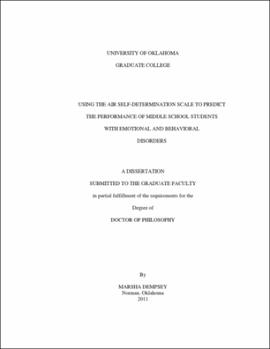| dc.contributor.advisor | Martin, James E. | |
| dc.creator | Dempsey, Marsha R. | |
| dc.date.accessioned | 2019-05-01T17:24:37Z | |
| dc.date.available | 2019-05-01T17:24:37Z | |
| dc.date.issued | 2011 | |
| dc.identifier | 99131757102042 | |
| dc.identifier.uri | https://hdl.handle.net/11244/319476 | |
| dc.description.abstract | Students with emotional and behavioral disorders (EBD) have historically faced discouraging outcomes in the four postsecondary outcome areas of employment, education, independent living, and community adjustment. These students usually begin to exhibit behavioral difficulties early in their school careers and typically interrupt and often stop their education at some point prior to or while in high school. Self-determination has become an effective educational tool for students with disabilities, and has been shown to lead to improved postschool outcomes. Students with EBD typically have lower levels of capacity for self-determination skills due to limited opportunities learn and practice self-determined behaviors. It is important to understand how middle school students with EBD view their levels of self-determination and what impact their perceptions have on their school engagement. | |
| dc.description.abstract | The purpose of this study was to describe how the perceived capacity and opportunity scores of middle school students with EBD on the AIR Self-Determination Scale (student version) were related to their grade point averages, school absences, and frequency of school disciplinary encounters. Using a correlational design, linear relationships between the subscale scores of capacity and opportunity on the student version the AIR Self-Determination Scale, were examined in relationship to the school engagement variables of grade point average, school absences, and school disciplinary encounters. | |
| dc.description.abstract | The participants were 36 middle school students, with emotional and behavioral disorders, ranging in age from 11 to 15 years, and 15 teachers who either directly taught students in the classroom or provided resource assistance daily. Data were collected in the last semester of the 2010-2011 school year using the AIR-S, student, and teacher demographic forms. Three multiple regression models were used to determine the correlational predictive relationships between the subscale scores of Capacity and Opportunity and GPA, Absences, and Discipline. General findings from this study revealed that when combined, higher scores for capacity and opportunity predicted higher student grade point averages, lower student absences, and lower disciplinary encounters for students at school. Additionally, findings demonstrated that increased opportunities at school to learn and practice self-determined behaviors predicted higher GPA's and lower absences, while opportunities at home to learn and practice self-determined behaviors predicted lower frequencies of disciplinary encounters for students at school. Results of this study suggest several major implications for instructional practices at school and home for middle school students with EBD. | |
| dc.format.extent | 148 pages | |
| dc.format.medium | application.pdf | |
| dc.language | en_US | |
| dc.relation.requires | Adobe Acrobat Reader | |
| dc.subject | Autonomy in children | |
| dc.subject | Middle school students--Psychology | |
| dc.subject | Problem children--Psychology | |
| dc.subject | Mentally ill children--Psychology | |
| dc.subject | Adjustment disorders in children | |
| dc.title | Using the AIR Self-Determination Scale to Predict the Performance of Middle School Students with Emotional and Behavioral Disorders | |
| dc.type | text | |
| dc.type | document | |
| dc.thesis.degree | Ph.D. | |
| ou.group | Jeannine Rainbolt College of Education::Department of Educational Psychology | |
